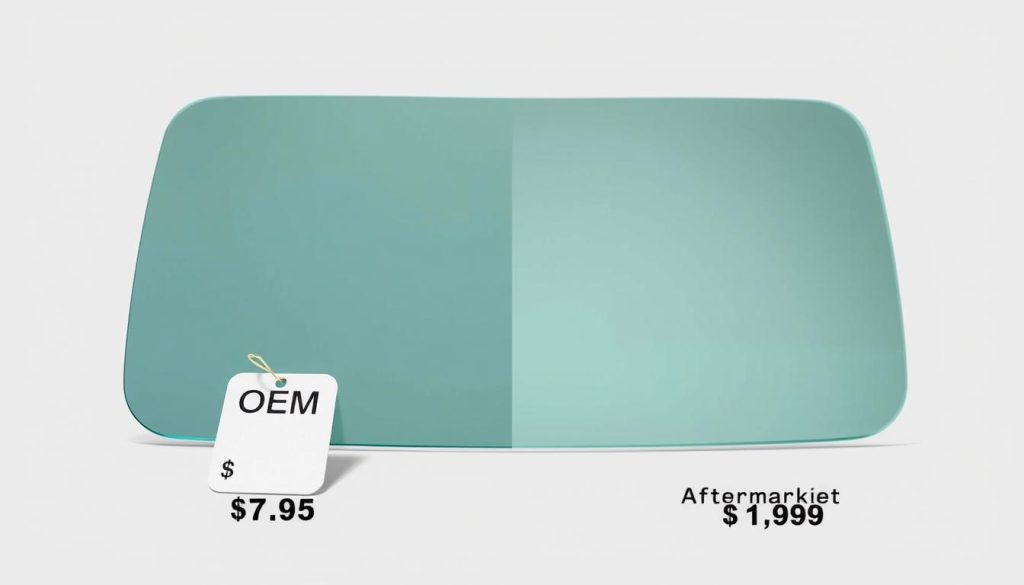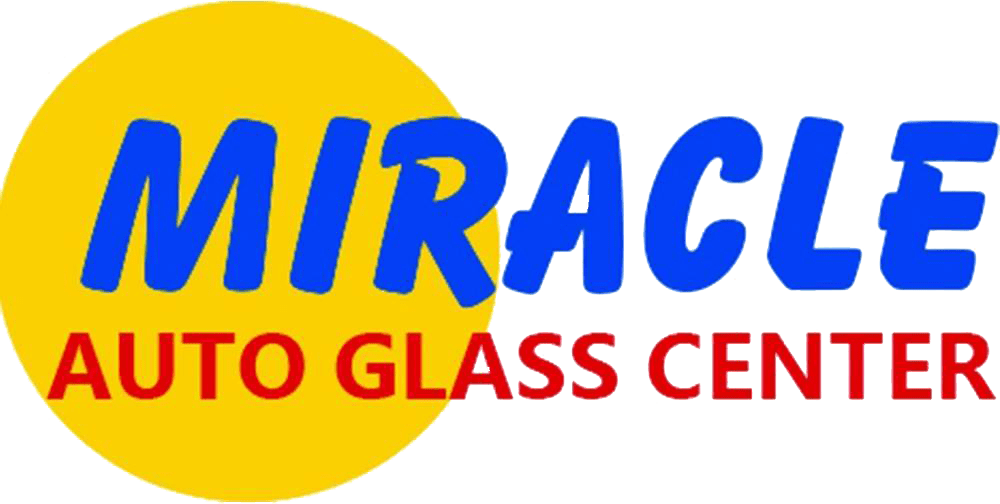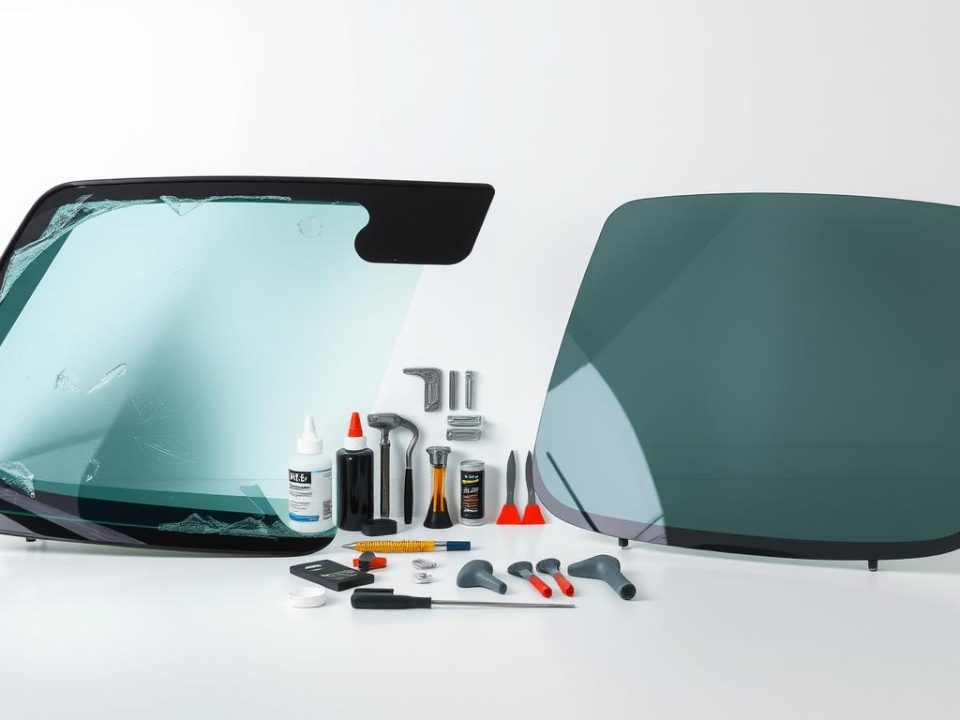
The Best Way to Clean Your Windshield for a Streak-Free Shine

How to Prevent Windshield Cracks from Spreading in the Texas Heat
When your vehicle’s windshield or other glass parts get damaged, picking the right replacement is tough.
You have two main choices: Original Equipment Manufacturer (OEM) or aftermarket parts.
Deciding between OEM and aftermarket auto glass depends on several things. These include how well they fit, their quality, and the price.
It’s important to know the differences between these options. This helps you make a choice that’s right for your vehicle.
Key Takeaways
- Understanding the difference between OEM and aftermarket auto glass is essential.
- Glass compatibility is a critical factor in choosing the right replacement.
- Quality and cost are significant considerations.
- OEM parts offer original quality, while aftermarket parts can be more affordable.
- Choosing the right auto glass ensures safety and optimal performance.
Understanding OEM Auto Glass
Choosing the right auto glass for your vehicle means knowing what OEM stands for. OEM stands for Original Equipment Manufacturer. This means the glass is made by the same company that made your car’s original glass or meets the same standards.
What Does OEM Stand For?
OEM stands for Original Equipment Manufacturer. When talking about auto glass, it’s the company that made your car’s original windshield or glass parts. OEM auto glass is made to fit perfectly and keep your car’s safety and performance just right.
Advantages of OEM Glass
Choosing OEM auto glass has many benefits:
- It fits perfectly, made to the exact original specs.
- It keeps your car’s safety and performance features intact.
- It usually comes with a warranty for any defects or installation problems.
- It might be needed to keep your car’s warranty valid.
It’s important to know that while OEM glass is top-notch, it can cost more than aftermarket options.
Disadvantages of OEM Glass
OEM auto glass also has some downsides:
- It’s usually pricier than aftermarket glass.
- It might take longer to get because of its specific nature.
- Some people might not see the need for OEM quality if their car is older or not driven in harsh conditions.
Knowing these points can help you decide if OEM auto glass is the best choice for your car.
Exploring Aftermarket Auto Glass
When looking at auto glass replacement, it’s key to know about aftermarket glass.
What is Aftermarket Glass?
Aftermarket auto glass is not made by your car’s original maker. It’s created by other companies that focus on glass. This glass might match your car’s original glass or have extra features.
Benefits of Aftermarket Options
One big plus of aftermarket glass is its lower cost. It’s cheaper than the glass made by your car’s maker. Also, you can find more styles and features, like systems that help with driving.
Key benefits include:
- Cost savings compared to OEM glass
- Wide availability and variety of options
- Potential for advanced features like ADAS calibration
Potential Drawbacks of Aftermarket Glass
Even with its benefits, aftermarket glass has downsides. The quality can differ a lot between makers. Some might not be as good as the glass made by your car’s maker. Also, it might not work well with your car’s systems, like ADAS.
| Feature | OEM Auto Glass | Aftermarket Auto Glass |
|---|---|---|
| Cost | Generally more expensive | Often less expensive |
| Quality | High, meets manufacturer standards | Variable, depends on manufacturer |
| ADAS Compatibility | Typically compatible | May require calibration, variable compatibility |
Key Differences Between OEM and Aftermarket
OEM and aftermarket auto glass differ in many ways. These differences can affect your car’s performance and safety. Knowing these differences helps you choose what’s best for you.
Cost Comparisons
Cost is a big factor when picking between OEM and aftermarket auto glass. Aftermarket glass is usually cheaper than OEM. But, the price gap depends on your car’s make, model, and the glass type needed.
Here’s a quick look at what you might pay:
- OEM auto glass: Prices range from $200 to $500 or more for a windshield, based on your car.
- Aftermarket auto glass: You might spend $100 to $300 for a windshield.
Remember, these are just estimates. Actual prices can change due to labor costs and extra features like rain sensors or tinted glass.

Quality Assessment
Quality is key for both safety and performance. OEM auto glass meets the same standards as your car’s original glass. It fits perfectly and is of top quality.
Aftermarket glass is also good but might not match OEM standards. Yet, many aftermarket brands offer quality that’s close to OEM.
Important quality factors include:
- Material and durability.
- How well it fits and looks.
- Its optical clarity and lack of distortion.
Availability and Options
Availability is another key factor. OEM glass is available for most cars but can take longer to get, for rarer or older models.
Aftermarket glass is easier to find and offers more choices. You can find different tints and features like acoustic or heated glass.
Think about these when looking at availability:
- How long it takes to get and install.
- The variety of options for your car.
- If it works with your car’s current features.
By looking at these points, you can make a choice that fits your budget, quality needs, and convenience.
Choosing the Right Option for Your Vehicle
Choosing between OEM and aftermarket auto glass requires careful thought. The type of glass affects your vehicle’s performance, safety, and look.
Factors to Consider When Selecting
Several factors are important when picking between OEM and aftermarket glass. Look at the quality of the glass, cost, and how it fits your vehicle. Windshield materials are key for durability and function.
Here are some key factors to consider:
- The make and model of your vehicle
- Your budget for the replacement or repair
- Personal preferences regarding quality and appearance
- The compatibility of the glass with your vehicle’s existing features
Your Budget and Preferences
Your budget is a big factor in choosing between OEM and aftermarket glass. OEM glass is pricier but matches your vehicle’s specs exactly. Aftermarket glass is cheaper but quality can vary.
Vehicle Make and Model Considerations
The make and model of your vehicle are key in picking the right glass. Different vehicles need different glass compatibility. Below is a table comparing OEM and aftermarket glass for various models:
| Vehicle Make | OEM Compatibility | Aftermarket Compatibility |
|---|---|---|
| Toyota Camry | High | Medium |
| Honda Civic | High | High |
| Ford Focus | Medium | High |
By considering these factors and understanding the implications, you can make a choice that meets your needs. This ensures your vehicle performs well and is safe.
Expert Opinions on OEM vs Aftermarket
Getting advice from industry experts is key when choosing between OEM and aftermarket auto glass. They share insights on the good and bad of each choice.
What Industry Professionals Recommend
Experts say OEM auto glass is best for cars with advanced safety features. This is because OEM glass is made to work perfectly with these systems.
ADAS Calibration is very important. It needs specific glass, which OEM glass provides. Aftermarket glass might not work as well with these systems.
| Feature | OEM Auto Glass | Aftermarket Auto Glass |
|---|---|---|
| ADAS Compatibility | Designed for seamless integration | May have compatibility issues |
| Cost | Generally more expensive | Often less expensive |
| Warranty | Typically comes with a manufacturer’s warranty | Warranty varies by manufacturer |
Common Misconceptions
Many think aftermarket glass is always worse than OEM. But, many aftermarket makers create glass that’s just as good as OEM.
Some also believe OEM glass is always the better choice. But, for cars without special safety features, aftermarket glass can be a cheaper, yet quality option.
Performance and Safety Concerns
Your car’s safety and performance depend on the auto glass type you pick. Whether it’s OEM or aftermarket, the glass must match your car’s safety features. This is key for keeping your car safe.
Impact on Vehicle Safety
The materials used in auto glass can change your car’s strength. OEM glass fits perfectly with safety features like lane departure warnings and adaptive cruise control.
OEM auto glass meets the maker’s exact standards. This ensures all safety features work right. But, aftermarket glass might not meet these high standards, risking your safety.
Warranty Considerations
When picking between OEM and aftermarket glass, think about the warranty. A good warranty gives you peace of mind and protects your investment.
| Warranty Aspect | OEM Auto Glass | Aftermarket Auto Glass |
|---|---|---|
| Coverage Period | Lifetime | Varied, typically 1-5 years |
| Parts and Labor | Included | Sometimes additional cost |
| Transferability | Yes, in most cases | Rarely |
Knowing the warranty details for OEM and aftermarket glass helps you choose wisely. It fits your needs and budget.
Installation: OEM vs Aftermarket
Choosing the right auto glass is just the start. How it’s installed is just as important. Both OEM and aftermarket glass need careful installation to work right.
Professional Installation Importance
Getting a pro to install your auto glass is key. They make sure the glass fits right and safety features like ADAS (Advanced Driver Assistance Systems) work well. ADAS calibration is a must for safety features like lane departure warning and adaptive cruise control.
Recommended Practices for Both Types
For both OEM and aftermarket glass, following the right installation steps is essential. This includes:
- Ensuring the new glass is properly sealed to prevent water leaks and maintain structural integrity.
- Calibrating ADAS systems according to the manufacturer’s specifications.
- Using the correct adhesives and following the recommended curing times.
By following these steps, you can make sure your new auto glass works as it should. For more on OEM vs aftermarket glass, check out our guide on OEM vs aftermarket glass.
Maintenance and Longevity
Proper maintenance is key to the longevity of your auto glass, whether OEM or aftermarket. The type of glass affects how well it handles environmental conditions.
How Each Type Holds Up Over Time
OEM auto glass fits perfectly with your vehicle, thanks to its high-quality materials. This ensures a longer lifespan. Aftermarket glass, while cheaper, may not last as long due to its quality and materials.
OEM glass is made with advanced windshield materials for better integration with safety features. Aftermarket glass might not fit as well with these features, affecting its performance and lifespan.
Signs of Issues to Look Out For
Watch out for signs of trouble with your auto glass, whether OEM or aftermarket. Look for:
- Cracks or chips that spread or block your view.
- Seal failure, shown by moisture between the glass layers.
- Improper fit, causing stress on the glass and frame.
Regular checks can spot these problems early. For more on OEM and aftermarket glass, visit our guide on what is OEM auto glass and what is aftermarket auto.
Choosing the right auto glass is key for your vehicle’s safety and performance. By picking the right glass and keeping an eye on its condition, you’ll drive safer.
Customer Experiences and Testimonials
Customers who picked OEM or aftermarket auto glass share valuable insights. Their feedback and stories help you understand what to expect. This knowledge is key when deciding.
Real-life Feedback on Choices
Those who went with OEM auto glass love its perfect fit and quality. A California customer said it cut down wind noise and improved visibility in the rain.
Customers who picked aftermarket auto glass talk about saving money and style. A Florida customer mentioned it was a cost-effective and stylish choice for their car.

Case Studies of Both Options
Here are some real-life examples:
- A Texas driver chose OEM glass for their luxury sedan. They wanted to keep the warranty and resale value.
- A New York family picked aftermarket glass for their minivan. They were happy with the quality and service.
These stories show different reasons for choosing OEM or aftermarket glass. They help you make a choice that fits your needs.
Choosing between OEM and aftermarket glass is a big decision. Knowing the impact of your choice can make you happy with your choice.
Why Choose Miracle Auto Glass for Your Needs
Looking to replace your vehicle’s glass? You need a reliable partner for a perfect fit and top performance. Miracle Auto Glass is your go-to, providing excellent services for OEM and aftermarket glass replacements.
Expertise in Auto Glass Replacement
Miracle Auto Glass has the know-how to handle all auto glass replacements. They ensure the glass fits your vehicle perfectly. Their team is up-to-date with the latest tech, including ADAS calibration, for your safety features.
Choosing Miracle Auto Glass means your glass damage will be fixed with care. They focus on quality and making customers happy. They’re the best for your auto glass needs.
Don’t let glass damage affect your vehicle’s safety and performance. Contact Miracle Auto Glass today. Schedule your appointment and see the difference their expertise makes.




